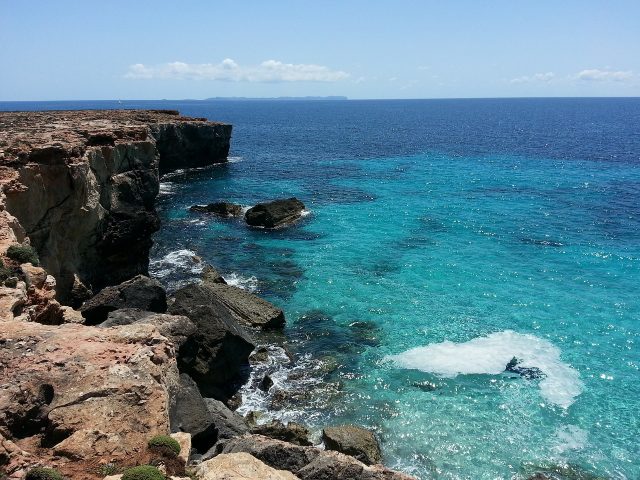Sunscreens, health and environment: a dangerous cocktail?

Prolonged exposure to sunlight is not recommended. Even though is really important to synthesize vitamin D which helps us absorbing calcium or phosphate and maintain a mineralized skeleton, the effects of sun´s ultraviolet radiation (mainly UVA and UVB) can be prejudicial in the long term. Main issues may be sunburn (UVB), reduced skin elasticity leading to premature ageing (UVA) or even skin cancer (type-dependent, but caused by both UVA and UVB), which can be lethal. Humans can minimize the effects of sunlight exposure by producing melanin, the natural pigment produced upon oxidation and polymerization of the amino acid tyrosine which has the property to effectively absorb UV radiation. Still, there is a limited amount of melanin that can be synthesized and even then, lengthy exposure can damage and result in mutations on melanocytes (a trigger for cancer), the cells responsible for producing it.
A way to circumvent such issues is to use sunscreens, which is essentially a cream that we spread onto the skin with the aim to protect it from the sun. Sunscreens contain UV filters that have a quantifiable protecting capacity, measured by the sun protection factor (SPF). Roughly, the SPF can be somewhere between 6 and 100 units and the higher the number, the more protection it provides, or more specifically it will protect you longer time than one with less SPF. Let´s imagine your skin starts burning after being exposed to the sun for 5 minutes, then using a 30 SPF sunscreen will increase by 30 times this time, hence your skin will start burning after 150 minutes. Sunscreens can also be tagged as “broad spectrum” meaning they protect from both UVA and UVB; these are highly recommended but also bearing in mind an SPF of 30 or higher is likely to give you an adequate protection.
We need sunscreens to prevent the negatives of sun exposure, but unfortunately, that comes with a price. There is a proportion of UV filters which are unsafe or even toxic for human consumption, which mainly comprises molecules belonging to the organic type of filters. There are two different groups of filters: organic or chemical and mineral or physical UV filters. Chemical filters include compounds that transform light energy into heat once UV radiation hits the molecule 1. They are quite effective, but few of them have been linked to toxicity. Typical commercial (and mainstream) chemical sunscreens with known adverse effects include p-aminobenzoate (PABA) derivatives, octocrylene, benzophenones (oxybenzone) or amiloxate. Published research suggests that endocrine disrupting actions and decreased male fertility mediated by these chemicals represent a growing health risk 23. The toxicity issues can be avoided by using organic (bio-) sunscreens containing mineral UV filters such as titanium dioxide and zinc dioxide. These filters reflect UV radiation instead of absorbing it and have the advantage of being found in mineral form in nature. In summary, people should be careful when choosing a sunscreen, especially when having children, as frequent use could potentially lead to health issues. But how about the environmental issues linked to the use of these creams?
Recently, a surprising (and potentially polemic) study published in PLoS One suggests the excessive use of sunscreen on coastal waters may be a new type of pollutant affecting the marine ecosystem. Perhaps more worrying is the study was not carried out in a remote island, but in the touristic Majorca islands (with millions of visitors during the summer), thus being a problem affecting the Mediterranean Sea (at the very least). The authors show that 4 of the main chemicals found in sunscreens (benzophenone-3, 4-Methylbenzylidene-camphor, titanium and zinc) can be detected in the surface microlayer (as most are lipophilic compounds) with concentrations ranging from 0.1 to 10 µg/L 4.Furthermore, the use of sunscreens releases inorganic nutrients such as phosphates to the coastline (PO43-) which concentration could increase 55%, on average. The reason why this may be threating to the environment is the impact these changes have in phytoplankton dynamics. The overall effect of increasing the concentration of sunscreen on the waters is algae growth inhibition and although concentration levels found in Majorca stayed below EC50 values (the concentration of sunscreen at which growth is inhibited by half), it shows the trend is already there. The effect of raising phosphate levels is a deregulation of the cell cycle response, which is synchronized to light-dark cycles 5. The net effect from such impairment is not clear, but the combination of both phenomena may certainly have an impact on photosynthesis and the balance of the whole near-shore marine ecosystem.
In summary, there is yet unexpected ways by which humans affect the environment (and their own health status). Perhaps local authorities should put in place ways to, at least, track these changes and evaluate the long-term impact. In the future, it may be necessary to implement certain mitigating measures that, although not popular it may help preserve our precious marine ecosystem.
References
- Stechschulte SA, Kirsner RS, Federman DG. Sunscreens for non-dermatologists: what you should know when counselling patients. Postgrad Med. 2011 Jul;123(4):160-7. doi: 10.3810/pgm.2011.07.2315. Review ↩
- Lichtensteiger W, Skakkebaek NE, Drzewiecki KT. Sunscreens: are they beneficial for health? An overview of endocrine disrupting properties of UV-filters. Int J Androl. 2012 Jun;35(3):424-36. doi: 10.1111/j.1365-2605.2012.01280.x. Review ↩
- Rehfeld A, Dissing S, Skakkebæk NE. Chemical UV Filters Mimic the Effect of Progesterone on Ca(2+) Signaling in Human Sperm Cells. Endocrinology. 2016 Nov;157(11):4297-4308. Epub 2016 Sep 1 ↩
- Tovar-Sánchez A, Sánchez-Quiles D, Basterretxea G, Benedé JL, Chisvert A, Salvador A, Moreno-Garrido I, Blasco J. Sunscreen products as emerging pollutants to coastal waters. PLoS One. 2013 Jun 5;8(6):e65451. doi: 10.1371/journal.pone.0065451. ↩
- Vaulot D, Lebot N, Marie D, Fukai E. Effect of Phosphorus on the Synechococcus Cell Cycle in Surface Mediterranean Waters during Summer. Appl Environ Microbiol. 1996 Jul;62(7):2527-33. ↩